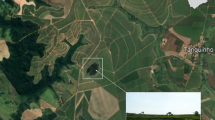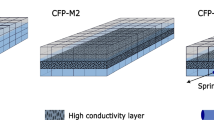Abstract
The purpose of this paper is to review the literature to characterize infiltration rates from landfill liners to support groundwater modeling efforts. The focus of this investigation was on collecting studies that describe the performance of liners ‘as installed’ or ‘as operated’. This document reviews the state of the science and practice on the infiltration rate through compacted clay liner (CCL) for 149 sites and geosynthetic clay liner (GCL) for 1 site. In addition, it reviews the leakage rate through geomembrane (GM) liners and composite liners for 259 sites. For compacted clay liners (CCL), there was limited information on infiltration rates (i.e., only 9 sites reported infiltration rates.), thus, it was difficult to develop a national distribution. The field hydraulic conductivities for natural clay liners range from 1 × 10-9cm s-1to 1 × 10-4cm s-1, with an average of 6.5 × 10-8cm s-1. There was limited information on geosynthetic clay liner. For composite lined and geomembrane systems, the leak detection system flow rates were utilized. The average monthly flow rate for composite liners ranged from 0–32 lphd for geomembrane and GCL systems to 0 to 1410 lphd for geomembrane and CCL systems. The increased infiltration for the geomembrane and CCL system may be attributed to consolidation water from the clay.
Similar content being viewed by others
References
Albrecht, K. A. and Cartwright, K.: 1989, ‘Infiltration and hydraulic conductivity of a compacted earthen liner’, Ground Water 27, 14–19.
Benson, C. H. and Daniel, D. E.: 1994, ‘Minimum thickness of compacted soil liners: II. Analysis and case histories’, J. Geotech. Eng. 120, 153–172.
Benson, C. H., Daniel, D. E. and Boutwell, G. P.: 1999, ‘Field performance of compacted clay liners’, J. Geotech. Geoenviron. Eng. 125, 390–403.
Bergstrom, W. R., Creamer, P. D., Petrusha, H. and Benson, C. H.: 1995, ‘Field Performance of a Double Liner Test Pad’, Geoenvironment 2000: Characterization, Containment, Remediation, and Performance in Environmental Geotechnics, Geotechnical Special Publication No. 46, American Society Civil Engineers, Reston, VA.
Bergstrom, W. R., Takacs, M. J. and Olson, M. A.: 1993, ‘Behavior of Five Operating Landfill Leak Detection Systems’, '93, Marina Del Rey, California.
Bonaparte, R.: 1995, ‘Long-Term Performance of Landfills’, Geoenvironment 2000: Characterization, Containment, Remediation, and Performance in Environmental Geotechnics, Geotechnical Special Publication No. 46, ASCE, New York.
Bonaparte, R. and Gross, B. A.: 1990, ‘Field Behavior of Double-Liner Systems’,Waste Containment Systems: Construction, Regulation, and Performance, Geotechnical Special Publication No. 26, American Society Civil Engineers, Reston, VA.
Bonaparte, R. and Gross, B. A.: 1993, LDCRS Flow from Double Lined Landfills and Surface Impoundments, EPA/600/R-93/070. NTIS Publication PB93–179885. Risk Reduction Engineering Laboratory, Office of Research and Development, U.S. EPA, Cincinnati, OH.
Bonaparte, R., Giroud, J. P. and Gross, B. A.: 1989. ‘Rates of Leakage through Landfill Liners’, Proceeding of the Geosynthetics 1989 Conference, San Diego, California.
Cartwright, K. and Krapac, I. G.: 1990, ‘Construction and Performance of a Long-Term Earthen Liner Experiment’, Waste Containment Systems: Construction, Regulation, and Performance, Geotechnical Special Publication No. 26, American Society Civil Engineers, Reston, VA.
Daniel, D. E.: 1984. ‘Predicting hydraulic conductivity of clay liners’, J. Geotech. Eng. 110, 285–300.
Daniel, D. E.: 1989, ‘In situ hydraulic conductivity tests for compacted clays’, J. Geotech. Eng. 115, 1205–1226.
Darilek, G. T., Laine G. L. and Parra, J. O.: 1989, ‘The Electrical Leak Location Method for Geomembrane Liners: Development and Applications’, Proceedings of the Geosynthetics 1989 Conference, San Diego, CA, pp. 456–466.
Day, S. R. and Daniel, D. E.: 1985, ‘Hydraulic conductivity of two prototype clay liners’, J. Geotech. Eng. 111, 957–970.
Eith, A. W. and Koerner, G. R.: 1997, ‘Assessment of HDPE geomembrane performance in a municipal waste landfill double liner system after eight years of service’, Geotextiles Geomembranes 15, 277–287.
Elsbury, B. R., Daniel, D. E., Sraders, G. A. and Anderson, D. C.: 1990, ‘Lessons learned from compacted clay liner’, J. Geotech. Eng. 116, 1641–1660.
Giardino, V. G. and Guglielmetti, J. L.: 1997, ‘Long-term performance of a hazardous waste landfill’, Geotextiles Geomembranes 15, 255–267.
Giroud, J. P., Badu-Tweneboah, K. and Bonaparte, R.: 1992, ‘Rate of leakage through composite liner due to geomembrane defects’, Geotextiles Geomembranes 11, 1–28.
Giroud, J. P. and Bonaparte, R.: 1989a, ‘Leakage through liners constructed with geomembranes-part I. Geomembrane liners’, Geotextiles Geomembranes 8, 27–67.
Giroud, J. P. and Bonaparte, R.: 1989b, Leakage through liners constructed with geomembranes-part II. Composite liners’, Geotextiles Geomembranes 8, 71–111.
Gordon, M. E., Huebner, P. M. and Kmet, P.: 1984, ‘An Evaluation of the Performance of Four Clay-Lined Landfills inWisconsin’, Seventh Annual Madison Waste Conference: Municipal and Industrial Waste, pp. 399–460.
Gordon, M. E., Huebner, P. M. and Miazga, T. J.: 1989, ‘Hydraulic conductivity of three landfill clay liners’, J. Geotech. Eng.. 115, 1148–1160.
Gross, B. A., Bonaparte, R. and Giroud, J. P.: 1990, ‘Evaluation of Flow from Landfill Leakage Detection Layers’, International Conference on Geotextiles, Geomembranes, and Related Products, The Hague, The Netherlands.
Hartley, R. P.: 1992, Surface Impoundments, Design, Construction, and Operation, Noyes Data Corporation, Park Ridge, New Jersey.
Huebner, P. M. and Gordon, M. E.: 1995, ‘Estimating Contaminant Breakthrough for a Clay-Lined Municipal Solid Waste Landfill’, Geoenvironment 2000: Characterization, Containment, Remediation, and Performance in Environmental Geotechnics, Geotechnical Special Publication No. 46, ASCE, New York.
Johnson, G. W., Crumley, W. S. and Boutwell, G. P.: 1990, ‘Field Verification of Clay Liner Hydraulic Conductivity’, Waste Containment Systems: Construction, Regulation, and Performance, Geotechnical Special Publication No. 26. American Society Civil Engineers, Reston, VA.
King, K. S., Quigley, R. M., Fernandez, F., Reades, D. W. and Bacopoulos, A.: 1993, ‘Hydraulic conductivity and diffusion monitoring of the Keele Valley landfill liner, Maple, Ontario’, Canad. Geotech. J. 30, 124–134.
Laine, D. L.: 1991, ‘Analysis of Pinhole Seam leaks Located in Geomembrane Liners Using the Electrical Leak Location Method: Case Histories’, Proceedings of the Geosynthetics 1991, Atlanta, GA, pp. 239–253.
Laine, D. L. and Miklas, M. P.: 1989, ‘Detection and Location of Leaks in Geomembrane Liners Using an Electrical Method: Case Histories’, ‘89, Proceedings of the 10th National Conference, pp. 35–40.
Laine, D. L. and Darilek, G. T.: 1993, ‘Locating Leaks in Geomembrane Liners of Landfills Covered with a Protective Soil’, Proceeding of Geosynthetics 1993, Industrial Fabrics Association International, St. Paul, MN.
Lichtwardt, M. A. and Comer, A. I.: 1997, ‘Geosynthetics in a Salinity-Gradient Solar Pond Environment’, Proceeding of Geosynthetics 1997, Industrial Fabrics Association International, St. Paul, MN.
Luettich, S. M., Bonaparte, R., Coleman, B. A. and Tomlinson, H. M.: 1995, ‘Preconstruction Testing of Two Soil Liner Materials’, Geoenvironment 2000: Characterization, Containment, Remediation, and Performance in Environmental Geotechnics, Geotechnical Special Publication No. 46, American Society Civil Engineers, Reston, VA.
Maule, J., Lowe, R. K. and McCulloch, J. L.: 1993, ‘Performance evaluation of synthetically lined landfills’, Tappi J. 76, 172–176.
McQuade, S. J. and Needham, A. D.: 1999, ‘Geomembrane liner defects-causes, frequency, and avoidance’, Proc. Institu. Civil Eng., Geotech. Eng. 137, 203–213.
Moo-Young, H. K. and Zimmie, T. F.: 1997, ‘Waste minimization and reuse of paper mill sludges as landfill covers: A case study’, J. Waste Manage. Res. 15, 593–605.
Mosley, N. G. and Crozier, F.: 1995, ‘Application of a Geomembrane Leak Location Survey at a U.K. Waste Disposal Facility’, Engineering Geology of Waste Disposal, Geological Society Engineering Geology. Special Publication No. 11, pp. 9–14.
O'sadnick, D. L., Simpson, B. E. and Kasel, G. K.: 1995, ‘Evaluation and Performance of a Sand/Bentonite Liner’, Geoenvironment 2000: Characterization, Containment, Remediation, and Performance in Environmental Geotechnics. Geotechnical Special Publication No. 46, American Society Civil Engineers, Reston, VA.
Othman, M. A., Bonaparte, R. and Gross, B. A.: 1997, ‘Preliminary results of composite liner field performance study’, Geotextiles Geomembranes, 15, 289–312.
Peggs, I. D.: 1993, ‘Practical Geoelectric Leak Surveys with Hand-Held, Remote, and Water Lance Probes’, Proceedings of Geosynthetics 1993, pp. 1523–1532.
Phaneuf, R. J.: 1996, A State's Perspective on CQA/CQC in Environmental Containment System Design and Construction, New York State Department of Environmental Conservation's Division of Solid Waste, Albany, NY.
Reades, D. W., Lahti, L. R., Quigley, R. and Bacopoulos, A.: 1990, ‘Detailed Case History of Clay Liner Performance’, Waste Containment Systems: Construction, Regulation, and Performance, Geotechnical Special Publication No. 26, American Society Civil Engineers, Reston, VA.
Rogowski, A. S.: 1985, ‘Effectiveness of a Compacted Clay Liner in Preventing Ground Water Contamination’, Proceedings of the Fifth National Symposium and Exposition on Aquifer Restoration and Ground Water Monitoring, pp. 412–429.
Rollin, A. L., Marcotte, M., Jacquelin, T. and Chaput, L.: 1999, ‘Leak Location in Exposed Geomembrane Liners using an Electrical Leak Detection Technique’, Proceedings of Geosynthetics 1999, pp. 615–626.
Sai, J. O. and Anderson, D. C.: 1990, ‘Field hydraulic conductivity tests for compacted soil liners’, Geotech. Testing J. 13, 215–225.
Tedder, R. B.: 1997, ‘Evaluating the Performance of Florida Double-lined Landfills’, Proceedings of Geosynthetics 1997, pp. 425–438.
Trast, J. M. and Benson, C. H.: 1995, ‘Estimating field hydraulic conductivity of compacted clay’, J. Geotech. Eng. 121, 736–739.
Trautwein, S. J. and Williams, C. E.: 1990, ‘Performance Evaluation of Earthen Liners’, Waste Containment Systems: Construction, Regulation, and Performance, Geotechnical Special Publication No. 26, American Society Civil Engineers, Reston, VA.
U.S. Environmental Protection Agency (U.S. EPA): 1992, Action Leakage Rates for Leak Detection Systems. Supplemental Background Document for the Final Double Liners and Leak Detection Systems Rule for Hazardous Waste Landfills, Waste Piles, and Surface Impoundments. EPA/530-R–92–004. NTIS Publication PB92–128214. Office of Solid Waste, Washington, D.C., January.
U.S. EPA: 1996, Report of 1995 Workshop on Geosynthetic Clay Liners, EPA/600/R-96/149, Office of Research and Development, Washington, D.C.
U.S. EPA: 1998, Assessment and Recommendations for Optimal Performance of Waste Containment Systems, Office of Research and Development, National Risk Management Research Laboratory, Cincinatti, Ohio, Draft Final.
U.S. EPA: 1999a, Guide for Industrial Waste Management, EPA/530-R–99–001, Office of Solid Waste and Emergency Response, Washington, D.C.
U.S. EPA: 1999b, Technical Background Document: Industrial Waste Management Evaluation Model (IWEM), Ground Water Model to Support the Guide for Industrial Waste Management, EPA530-R–99–002.
U.S. EPA: 1999c, User's Guide for the Industrial Waste Management Evaluation Model (IWEM): Tier 1 Look-Up Tables and Tier 2 Neural Networks, EPA530-R–99–003.
U.S. EPA: 2001, Industrial Surface Impoundments in the United States, EPA530-R–01–005.
Wilson-Fahmy, R. F. and Koerner, R. M.: 1995, ‘Leakage Rates through Holes in Geomembranes Overlying Geosynthetic Clay Liners’, Proceeding of Geosynthetics 1995, pp. 655–668.
Workman, J. P.: 1993, ‘Interpretation of Leakage Rates in Double-Liner Systems’, Proceedings 7th Geosynthetic Research Institute Seminar, pp. 95–112.
Author information
Authors and Affiliations
Corresponding author
Rights and permissions
About this article
Cite this article
Moo-Young, H., Johnson, B., Johnson, A. et al. Characterization of Infiltration Rates from Landfills: Supporting Groundwater Modeling Efforts. Environ Monit Assess 96, 283–311 (2004). https://doi.org/10.1023/B:EMAS.0000031734.67778.d7
Issue Date:
DOI: https://doi.org/10.1023/B:EMAS.0000031734.67778.d7




